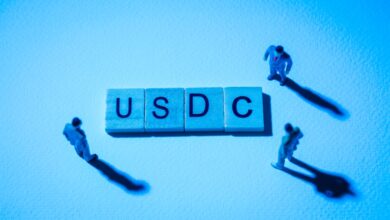Cryptocurrency Risk Management: Simple Rules To Follow For Crypto Trades

Risk is a likelihood that something bad may happen due to your actions, an occurrence that has the opposite effect of what you planned. Investing in cryptocurrencies entails a degree of risk. A trader’s risk of receiving an undesirable result is translated into a trader’s risk of losing money. A short position with a 50% risk indicates that there is also a 50% chance that the price of Cryptocurrency will increase, which means that you will lose money. There is no such thing as a perfect strategy, and the best traders in the market are aware of this. Since risk management comes first and trading comes second to these traders, they are successful traders.
Every serious trader should have a trading strategy in place. With a trading strategy, you may achieve various benefits, from anxiety management to losing fewer trades and being more mindful of your trading patterns, making extremely focused improvements and approaching trading as a serious endeavour.
Risk management tools including Stop-losses and Total Money at Risk help safeguard your investment capital from large losses. Never put funds into an investment that you cannot afford to give up. Trade cryptocurrency with surplus funds to disconnect feelings from your trading choices. With greater risk management, bitcoin trading may be tremendously rewarding. But, if it is not performed correctly, a trader might incur large losses.
Risk management in the cryptocurrency market
Almost all cryptocurrency newcomers lose money. The fundamental cause for this is a lack of risk management abilities, leading to premature actions. Risk management is essential to avoid losing your entire investment on your first day in the crypto-trading market
.
The cryptocurrencies market is expanding at a rapid rate. A perfect example of this may be seen around the end of this year. People seem to be forgetting that cryptocurrency trading isn’t only about making money. It’s also about taking risks. You must also follow risk management guidelines if you don’t need to lose your money right away. Your profits will soar, and your damages will be minimized if you use the appropriate method.
Risk refers to the potential for a trader’s invested money to be wiped out. The capacity to forecast and limit any losses resulting from a failed transaction is, thus, defined as “risk management.” What is the significance of risk management? Let me give you a concrete illustration of what I mean. A robust and reliable cryptocurrency project like Ripple convinced you to put your whole savings in it. XRP, on the other hand, fell when you least expected it to happen. As a result, the price has fallen by as much as half. Since Ripple’s inception, it has seen a constant fluctuation in its price.
To put it simply, if you lose 50% of your investment in a single trade, you’re out of luck. This is a dramatic illustration. It’s uncommon for even novice traders to make such clear blunders. However, it’s important to remember that trading without a risk management plan is a certain way to lose money.
Manage your risks to increase your profits
Astonishing increases were made by most of the main currencies in the cryptocurrency market last year. For many people, the advent of decentralized finance has sparked a newfound interest in yield farming and the possibility of generating a comfortable passive income from cryptocurrencies. Traders are flocking to the cryptocurrency market in the face of a faltering international economy and near-negative returns on conventional deposits.
Large-scale sponsorships from investment firms and significant companies, like MicroStrategy, Guggenheim, PayPal and Square, have all lent respectability to the project while fueling the fear of missing out on a good investment opportunity. This year, the price of Bitcoin (BTC) has risen like a rocket, surpassing its former all-time high mainly to institutional buying.
The demand for more complex risk management methods that go above simple market procedures and enable strong professional traders to conduct extremely configurable and innovative approaches that cover their risk throughout all assets while enhancing the possible returns is increasing as institutional traders become more interested in trading options.
Recently, risk management tools formerly unavailable to cryptocurrency exchanges have become more widely available. This trader requires an exchange that provides the necessary components to cross-collateralize their holdings and manages risk more efficiently, and reputable platforms have to provide that.
Statistics, Probability, and Risk
According to conventional opinion, it’s advisable to start investing in bitcoin with a modest portion of your overall investable funds. Risk-benefit ratio and statistics are the foundations of that knowledge, which may be summarized as follows:
Larger bid sizes are associated with more potential risk and profit per position. Short-term gains are good, but long-term gains are only possible if the risks are minimal. Larger bidding sizes carry a higher risk than prospective profits, as shown by long-term statistics.
In the long run, smaller bets may take you longer to reach your goal, but you will have additional possibilities to profit and prevent losses. There will be less dependence on chance and more space for skills. More potential for significant successes and mistakes will be available for the occasional poorly timed buying in the crypto market.
This is true in all investment areas, but it is particularly true in trading. Furthermore, the above is particularly true in cryptocurrency investment and trading, where the historically high volatility means that there are few sure bets and many possibilities to lose 50% or more of a stake on an untimely entrance into the market. Those points will be explained in greater detail in the following sections and additional examples.
What are the best ways to profit from trading short positions? Setting stops to restrict a trade’s loss is important in trading. The objective behind dollar-cost averaging in long-term investing is to accumulate modest investments into a larger one, which you can then trade for a profit later. Small bids mean that each missed buy or stop opportunity costs you only a small sum. You might lose a lot of money in a short period if you purchase at the wrong moment or in the wrong place.
We will go over some basic guidelines for minimizing your exposure to risk while trading Cryptocurrency.
Types Of Hazards
There are four basic categories of financial risks in the cryptocurrency trading world:
- Risk of Credit
Cryptocurrency ventures face this danger. A cryptocurrency project’s failure to meet its contractual commitments is called “failure risk.” Financial fraud is the main cause of credit risk in the cryptocurrency market. A prominent example is the Binance breach of 2018, which caused the loss of 40 million dollars.
- Legal Risk
If anything bad happens in relation to regulatory requirements, it’s called a legal risk. An example of this would be a country-specific restriction on the trade of cryptocurrencies. An example of a real-world legal danger is the case of the Bitconnect cryptocurrency exchange, which Texas and North Carolina ordered to stop and refrain from doing business.
- Liquidity Risk
Suppose a trader refuses to cooperate and cannot transfer their entire investment into fiat currencies that they can utilize in their day-to-day expenditures. In that case, this is referred to as liquidity risk in cryptocurrency trading.
- Risks to the Market
While holding an available position, market risk is the possibility that the value of your coins may rise or fall in opposition to your goals.
- Risks associated with Operations
A trader can lose all the amount they have in their cryptocurrency wallets because of operational risk.
For maximum trading options, risk management should be improved.
Trading accounts, deals, and cryptocurrency assets can all be managed from a single platform, thanks to single account management (also known as Portfolio Margin) and portfolio margin. They may also use their absolute buying power to trade with whatever instrument they want since they can pool their assets under one roof.
The control of risks is, without a doubt, the most crucial aspect of investment. Risk-management techniques that optimize returns for traders while pushing the cryptocurrency market value into the trillions of dollars are essential if the cryptocurrency field keeps growing and attracting and retaining professional traders’ attention and investment.
How to Avoid Losses and Manage Risks
If you put your whole amount into one Cryptocurrency and plummeted by 50% overnight, you would lose most of your money. However, the damage would have been less severe if you only held ten assets and Xrp represented just 10% of your total investment. Because of this, a diversification strategy is a must! Always keep an eye on the market and diversify your cryptocurrency portfolio.
Secondly, Determine the Amplitude of the Deal.
Traders are generally influenced by their feelings rather than their rationality or logical reasoning. Even a specific phrase has been coined to characterize the phenomena. FOMO, or “fear of missing out,” is used to describe this phenomenon.
Beginning traders, swept up in a frenzy, make rash decisions, including putting 30-40 per cent of their initial investment in a single transaction, which may result in substantial losses if the trade goes wrong. The 6 per cent and 2 per cent rules should not be overlooked for this reason.
You should only use 2% of your total deposit to create a trade, according to the latter. Some even discouraged investing no more than 1% of the amount. You won’t have to worry about running out of money with this method.
You must discontinue trading if you drop more than 6% of your investment in cryptocurrency trading if it keeps happening. A 1.5–2 week gap from trading is advised in this situation so that you might mentally recuperate and avoid making hasty judgments.
A significant connection exists between this concept and the limitation on capital losses. The cumulative risk of all orders should not exceed 25% when you join a position.
So, even if none of your transactions is lucrative, you’ll still retain at least 75% of your initial investment.
Calculate the return on investment for a given transaction.
Make sure you understand that not all transactions are going to payout. Even the most experienced traders suffer financially from time to time. Trading has risks, and you must learn to deal with them. Most importantly, the profit/loss ratio must be considered. At least 3 to 1 is ideal, but a minimum of 2 to 1 is preferable.
The most common blunders made by novice investors
Learning from your failures is a terrific, yet pricy, method to achieve success. Consequently, we’ve compiled this list of the most common blunders made by novice traders.
Keep track of your losses, and don’t succumb to the temptation of greed.
Having self-confidence is an asset, but being overconfident may be a trap, particularly when trading cryptocurrencies. It’s possible that even with the most accurate projections, the sale may not be beneficial for you.
In many cases, traders’ self-confidence is the driving force behind their decision to commit 30-40 per cent of their deposit. They are certain that Cryptocurrency’s value will continue to rise. But there is no guarantee that the price will increase. So, To avoid losing too much of your first investment, develop a sound plan and play it safe.
Another common rookie error is the failure to use stop-loss and take-profit bets. A stop-loss order instructs the exchange to cancel a deal when a predetermined price loss threshold is achieved.
A Stop Loss order is an order that terminates a trade when the price falls below a certain threshold. Active orders may be closed if the price rises to a certain threshold using a Take Profit order. Both methods are effective in mitigating risk. Trading Stop Losses and Take Profits keeps you out of losing trades and allows you to go through a position just before the market turns against you.
If the exchange rate fluctuates, you may employ Trailing Stop Losses and Take The profits. However, the bulk of cryptocurrency exchange does not provide this functionality.
To show how this works, let’s say you purchased some Tokens for $1.7k. You assumed that the coin’s price would climb after a technical analysis. Although the cryptocurrency marketplace is unpredictable, you need to take precautions.
Take-profit orders are significantly more difficult. Beginners often fail to recognize when they have made a profit and when it is time to complete a transaction because they lack the experience and knowledge to do so. Keep in mind that the desire for more does not always result in positive consequences. Make sure you know your take-profit level ahead of time and close the trade when you achieve it. The price trend might change at any moment, and you will not just miss out on profits, but you will possibly lose money.
Techniques for Success
Embrace Mistakes
Every trade comes with some level of risk. In addition, we can’t remove it, but we can control it. To achieve gains in future transactions, you should accept your mistakes and depend on plan-based judgement to minimize risk.
Pay attention to the charges.
The costs associated with trading might be a mystery to new traders. Such costs include, but are not limited to, withdrawals fees, leveraging fees etc. You should take them into account when planning your risk management strategy.
Keep an Eye on Your Winning Percentage.
Trading may be discouraging because of the inherent dangers and obvious risks. Concentrating on the number of times you succeed, on the other hand, might help you build a more favourable response about trading.
Take a Look at Your Pullback
When you suffer a succession of losses, the entire amount of your beginning cash is reduced to nothing. For example, if you lose $1 million out of $5,000, your fall percentage is 10%. ” For a given dollar amount, you’d need to put more money into the deal for it to make a profit.
Leverage Should be Used Wisely
It might be quite tempting to take advantage of leverage to generate large gains. However, this may also make it quite simple to lose a significant amount of money. Do not encourage the application of huge leverage. An unexpected shift in the market’s position is all it takes to wipe out your whole trading history.
When it comes to managing cryptocurrency risk, it isn’t tough. If you want to participate in any financial instrument—whether it’s bonds or ETFs or stocks or cryptocurrencies—you’ll require extensive risk management skills. The most difficult element is maintaining the self-control necessary to follow the guidelines of this risk management strategy even when the market goes against your investments.
Conclusion
It’s possible to make a lot of money despite the considerable risks connected with cryptocurrency trading. You won’t find a Lamborghini around the block, but you may earn a lot of money with the appropriate investments. Futures trading has the potential to be very lucrative, particularly when leveraged. It’s possible to lose all of your money if you don’t grasp how it works and how to limit the dangers involved with it. If you want to invest a lot of money, you should check into Cryptocurrency. You can increase your profits and decrease your losses by using proper financial and risk management while trading Cryptocurrency.
To be successful in trading, one must have a firm grasp of the dangers involved and how to mitigate them. If you want to invest like an expert, the first step is to understand how to deal with risk!
Tokenhell produces content exposure for over 5,000 crypto companies and you can be one of them too! Contact at info@tokenhell.com if you have any questions. Cryptocurrencies are highly volatile, conduct your own research before making any investment decisions. Some of the posts on this website are guest posts or paid posts that are not written by Tokenhell authors (namely Crypto Cable , Sponsored Articles and Press Release content) and the views expressed in these types of posts do not reflect the views of this website. Tokenhell is not responsible for the content, accuracy, quality, advertising, products or any other content or banners (ad space) posted on the site. Read full terms and conditions / disclaimer.







